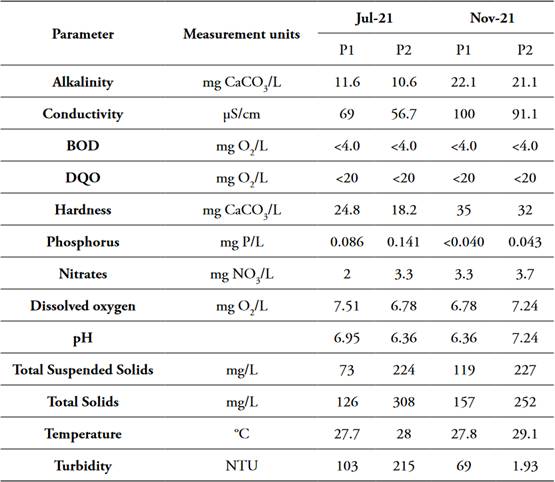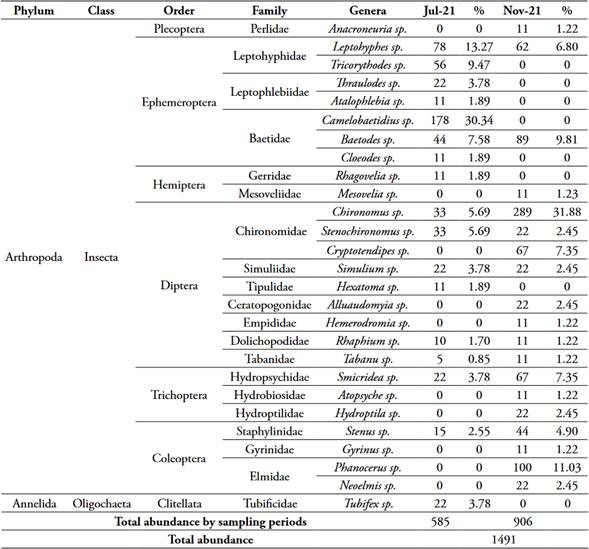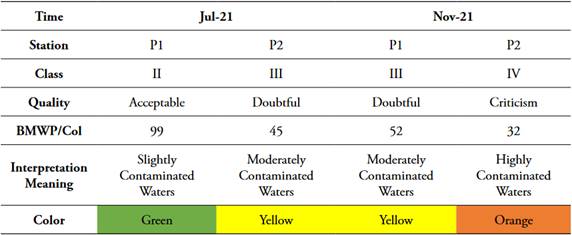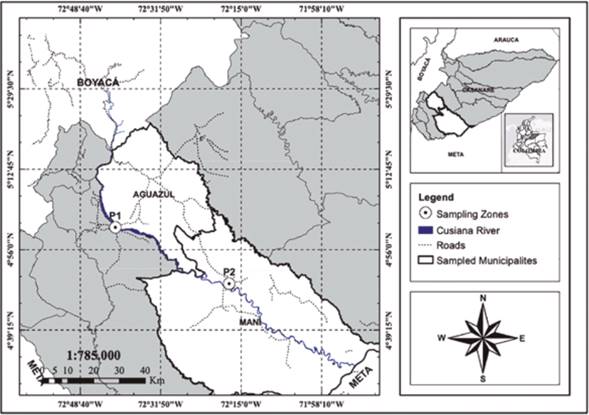Introduction
Freshwater bodies including lakes and rivers are directly impacted by processes occurring within the drainage area of their respective watershed (González, et al., 2012; Jiménez and Vélez, 2006). The damage caused by point source pollution can be more significant than it initially appears, leading to negative impacts on aquatic ecosystems populations (Riss et al., 2002; Torrado, 2016). Pollutants can come from specific industries or domestic sewers on a small scale (Gamboa, et al., 2008), while on a larger scale, pesticides and fertilizers used in agriculture, as well as sediment runoff from deforested areas can affect freshwater bodies (Alba-Tercedor, 1996; Torralba and Alonso, 2011). These activities have direct consequences on the quality of water consumed by local populations, the aquatic biota, and can indirectly affect the terrestrial biota (Terneus, et al., 2012; Xie et al., 2003). Pollution sources in aquatic systems are determined by multiple factors (Roldán-Pérez, 1999). Depending on the point of access to the receptor, pollution sources can be classified as specific, where wastes are discharged at easily identified points, or diffuse, where pollutants are added to runoff water and enter water bodies through numerous sites scattered along the watershed (Castellanos, et al., 2017; Trama, et al., 2020).
Thus, understanding lotic systems as complex and dynamic ecosystems that interact with surrounding terrestrial ecosystems depends heavily on the lithological characteristics of the terrain they traverse and the prevailing climatic conditions. Lotic systems exhibit a hierarchical hydrographic structure, which results in different dynamics in headwaters, middle reaches, and lower reaches, creating diverse habitats along the river course and contributing to biodiversity by (Dügel and Kazanci, 2004; Giacometti and Bersosa, 2019). Therefore, evaluating water quality in these ecosystems is essential in determining their conservation status and the potential utilization of this valuable resource (Rodríguez-Zambrano and Aranguren-Riaño, 2014; Zúñiga et al., 1994).
Water quality studies involve analyzing various physical properties, including temperature, color, appearance, conductivity, turbidity, and total solids. Chemical properties such as pH, alkalinity, acidity, nutrients (phosphorus and nitrogen forms), and heavy metals are also examined (Guerrero and Romero, 2018). Bacteriological studies focus on determining the contamination of surface waters by fecal and total coliforms (Cifuentes, et al., 2014). Hydrobiological studies, particularly investigating benthic macroinvertebrates, play a crucial role in assessing the current condition of a water body (Roldán-Pérez, 2009).
The analysis of physicochemical and bacteriological properties, along with hydrobiological studies, allows for the identification of interventions or disturbances in aquatic systems. Benthic macroinvertebrates are widely recognized as excellent indicators of water quality in aquatic ecosystems due to their long life cycles and high diversity (Roldán-Pérez, 2016). It is important to emphasize the consideration of physicochemical parameters that are of significant limnological relevance when studying them, enabling the application of indicators that reflect the system’s state (Rocha, et al., 2015; Walteros-Rodríguez, 2010).
Despite the significant diversity and the crucial role of aquatic macroinvertebrates as indicators of the conservation status of aquatic systems, there is still a lack of knowledge regarding their biota and the evaluation of water quality in the eastern region of the country (Roldán-Pérez, 2009, 2016). Therefore, the objective of this study was to assess water quality using aquatic macroinvertebrates and physicochemical variables at two sampling stations located in the lower basin of the Cusiana River, specifically between Aguazul and Maní in the department of Casanare, Colombia.
Materials and methods
Study area
The Cusiana River originates in the Páramo of the Sarna at an altitude of 3200 meters above sea level (m.a.s.l.) in the department of Boyacá. After a 245-kilometer journey, it flows into the Meta River in the jurisdiction of the municipality of Maní (Casanare). This water system receives water from the Salineros, Recetor, Caja, Chitamena, Unete, and Charte rivers, and other streams and creeks. The region has a bimodal hydrological cycle with an average annual precipitation of 1370 mm/year and periods of high precipitation between April and July and low precipitation between November and March. Two sampling points were prioritized in the lower basin of the Cusiana River (Fig. 1), taking into account the Departmental Development Plan of Casanare 2020-2023, which identifies the headwaters of the municipalities of Tauramena and Maní as the most affected areas by water quality due to their main socio-economic activities. Two monitoring campaigns were conducted: the first in July 2021 during the rainy season and the second in November 2021 during the drought.
Likewise, sampling points were strategically established in areas with a significant presence of anthropogenic activities, point 1 (P1) located on the Aguazul riverbank (Fig. 1), which has permanent streams, an approximate width of 400 m, an average depth of 60 cm, and predominantly coarse and small rocks, with arboreal vegetation on both banks.
Point 2 (P2) is located in the municipality of Maní (Fig. 1), it has an approximate width of 350 m, an average depth of 4.5 m, and tree-type vegetation cover of on both banks. Additionally, there are settlements such as stadiums and boatmen areas. The water at this point appeared more turbid compared to P1, with an absence of rocky substrate. The bottom predominantly consists of soft soil, composed of coarse and fine sands, resulting from decomposing organic matter. There was evidence of foul odors and foreign substances within the source.
Field and laboratory work for Physicochemical analysis
At each sampling point, 15 parameters were analyzed. In situ measurement were taken for temperature, pH, electrical conductivity, and dissolved oxygen using a multiparameter probe (HI 9829). Alkalinity, Biological oxygen demand (BOD), Chemical oxygen demand (COD) total hardness, total phosphorus, nitrates, total suspended solids (TSS), and turbidity were analyzed at the Environmental Analysis Laboratory of the Universidad de Boyacá.
Field and laboratory work with benthic macroinvertebrates
The collection of macroinvertebrates was conducted based on the microhabitats location, with five subsamples taken to cover the identified karyotypes. The approach aimed to achieve a greater representation of the stream and integrate them into a single sample, which was then preserved with the Rose Bengal solution. It is important to note that the two sampling points had different hydrological and hydraulic conditions during the two periods evaluated. Therefore, two different sampling methods were employed: a net with an area of 0.45 m2 (30*30 cm) placed against the current due to the lightness of the system in P1, and a core sampler with an area of 0.045 m2 (3 inches in diameter, 15 cm high) used for sediments sampling in P2.
Sample processing took place at the Biology Laboratory of the Universidad de Boyacá. The samples first were washed in 500 and 250 μm sieves to separate the organisms from the fine sediment and remove excess organic matter. Subsequently, they were then transferred to white trays and observed under a white light lamp to remove the organisms.
Individuals were identified using a stereoscope (NIKON SMZ 1500) and taxonomic determination was aided by specialized literature including Roldán-Pérez (1996), Manzo (2005), Heckman (2006), Posada-García and Roldán-Pérez (2003), and Domínguez and Fernández (2009).
Data Analysis
The results obtained from the composite samples were assessed using the water quality indexes ICA NFS, ICOMI, ICOMO, ICOTRO, and ICOSUS. These indexes, described according to the methodology of Ramírez, et al. (1997), provide an evaluation of water quality.
To analyze the macroinvertebrate community data, the BMWP/Col index adjusted by Roldán-Pérez (2003) was applied. This index allows for the assessment of the quality of the aquatic ecosystem by determining the tolerance range of different representative families from various orders. The index is defined on a scale of 1 to 10, with 10 indicating the highest sensitivity and 1 indicating the highest tolerance, based on their adaptations to pollution. The scores for each family found at each sampling point were then summed to calculate the index and evaluate the water quality (Forero, et al., 2014).
Results and discussion
Physicochemical analysis
According to the results obtained, 2 out of the 15 evaluated parameters, BOD and COD, recorded values below the specified limits, with values < 4.0 and < 20 mgO2/L, respectively (Table 1).
In the case of turbidity at P1, values of 103 and 69 nephelometric turbidity units (NTU) were recorded for the two sampling periods, respectively (Table 1). These values could be attributed to the specific time periods assessed. The first period was characterized by prevailing rains, resulting in increased current velocity and flow, which enhanced the capacity of the river to carry suspended material. Additionally, contributions from adjacent soils through runoff processes could have reached the main channel (Alba-Tercedor, 1996). Regarding the second sampling period, it is worth noting that although there was no significant rainfall influence, there were isolated rains a few days earlier, which could explain the high turbidity values.
Similarly, at P2, turbidity registered high values, ranging from 215 to 1.93 NTU across the two sampling periods, respectively. It is important to highlight that the channel configuration undergoes substantial changes at this point. The river widens, its depth increases, and the drainage channel expands. The composition of the riverbed also changes from rocks and boulders to silts, clays, fine and coarse sands. Moreover, significant contributions from the municipality and from tributaries such as Caja and Unete, the latter in proximity to the monitoring point, have likely affected turbidity levels.
Table 1 Results of the physicochemical analysis for the sampling points (P1) in the municipality of Aguazul, and (P2) in the municipality of Maní, during the two sampling periods.

Source: Own elaboration.
In the second monitoring, a slight increase in Total Suspended Solids (TSS) was observed. In P1, the TSS increased from 73 to 119 mg/L, while in P2, it showed a minimal increase from 224 to 227 mg/L (Table 1). These suspended particles consist of clays, sediments, colloidal organic particles, particulate matter, plankton and other microscopic organisms (Arciniegas, 2012).
During the second monitoring, the pH values were slightly basic. In P1, the pH was reported as 6.36 units, and in P2, it was 7.24 units (Table 1). These increases could be attributed to the continuous washing of rocks upstream, particularly in P1, which releases bicarbonate ions into the environment (Guerrero and Romero, 2018; Kalibbala et al., 2006). Additionally, the contributions from the tributaries (Caja and Unete rivers) may have influenced the pH levels. It is important to note that the pH value can vary from one section to another, as indicated by the low alkalinity levels with average values of 16.85 mg CaCO3/L for P1 and 15.85 mg CaCO3/L for P2.
The concentrations of dissolved oxygen along the river were favorable. In P1, the values were 7.51 (99.08% saturation) and 6.78 mg/L (100.4% saturation) for the two sampling periods, respectively (Table 1). In P2, the concentrations were 6.78 mg/L (88.05% saturation) and 7.24 mg/L (94.03 % saturation), respectively (Table 1). These values are likely influenced by factors such as the longitudinal slope of the stream, bed shape, sediment size, and geology of the terrain (Arias-Madrid, et al., 2012), as well as the effects of wind on the water surface (Jacobsen et al., 1997).
The electrical conductivity recorded a value of 69 μS/cm in P1 and 56.7 μS/cm in P2 during the first sampling (Table 1). These values are consistent with the observed conditions in each station, including the release of ions due to the mineralization of rocks in P1 and the contributions received in P2, including those from the Unete River and the Cusiana River from the from the municipality of Maní. In the second monitoring, considering the recorded rains in the days preceding the sampling (occasional rains), the conductivity increased by approximately 31 μS/cm for P1 and around 40 μS/cm in P2 (Table 1).
From a nutrient perspective, specifically nitrogen and phosphorus, which are the main nutrients responsible for eutrophication, the following results were observed: nitrates concentrations were measured at 2.0 and 3.3 mgN-NO3/L for P1 and P2 respectively during the first sampling (Table 1). These concentrations slightly increased during the second monitoring, reaching values of 3.3 and 3.7 mgN-NO3/L for P1 and P2 respectively (Table 1). The slight increases in nitrate concentrations are likely related to the rainfall that occurred in the days preceding the sampling. Rainfall can contribute to the leaching of organic and inorganic compounds, including detritus, into the lotic aquatic system (Forero, et al., 2014; Soto, et al., 2000; Maltby, 1991).
Total phosphorus concentrations were found to be 0.086 and 0.141 mg P/L for P1 and P2 respectively, during the first sampling (Table 1). These values indicate the occurrence of eutrophication processes (Soto et al., 2000; Ledesma et al., 2013). However, for the second sampling, the phosphorus concentrations in P1 were below the detection limit of the analytical method employed by the laboratory for (<0.04 mg P/L) (Table 1). P2 recorded concentrations of 0.043 mg P/L, suggesting that the stream was in a mesotrophic state (Andrade, et al., 2010).
Water quality indexes
According to the results obtained using the ICA NSF index, the water quality at the sampling points on the Cusiana River during both periods evaluated was classified as Medium, with a slight increase in the latter period, indicating no significant change in the level of contamination. Stefouli (2005) suggests that factors such as sunlight hours, temperature, and absence of rain, and the size of the water body contribute to maintaining the equilibrium of the parameters under these conditions.
Furthermore, the evaluation of water quality based on the contamination indexes (ICO’s) provides a qualitative understanding of the extent of anthropogenic impact on aquatic systems. These indexes consider various types of pollution, including sediment discharge, fertilizers usage in crops, and nutrient input on lotic or lentic systems (Ramírez, et al., 1997; Restrepo-Manrique, 2013; Restrepo-Manrique and Salcedo-Reyes, 2018).
Both sampling points exhibited similar contamination patterns, characterized by “Very Low” mineralization, with ICOMI values of 0.05 and 0.04. There was a slight increase in the second sampling period, with values of P1: 0.09 and P2: 0.08, possibly influenced by the increased alkalinity, conductivity, and hardness (Paukert and Willis, 2003).
When applying the ICOSUS index, contamination levels remained within the same range for both sampling periods, indicating “Low” contamination, with values of 0.2 and 0.34 respectively. In the second period, there was an increase of 0.14 in the index, which correlated with an increase in solids concentration from 73 to 119 mg/L, possibly due to rainfall changes prior to sampling. In P2, similar to P1, the “High” contamination by solids was observed, with minimal differences between the two periods (224 mg/L in July 2021 and 227 mg/L in November 2021). These variations could be attributed to factors such as the nature of the drainage basin, channel configuration, changes in hydraulics, upstream tributaries, among others (Rice, et al., 2001; Stefouli, 2005).
According to the ICOMO index, the water quality at P1 was classified as “Low” contamination during the first sampling, while P2 was classified as “Medium” contamination. In the second sampling, there was a change only for P2, which shifted from “Low” to “Medium” contamination with an ICOMO value of 0.34. This change was likely due an increase in the concentration of total coliforms, ranging from 10190 to 18190 NMP/100 mL, and a decrease in oxygen concentration, resulting in a variation in oxygen saturation varied from 7.24 mg/L (94.03% saturation) to 6.78 mg/L (88.05% saturation) (Table 1).
P1 maintained favorable conditions for good aeration, as indicated by the oxygen saturation percentage of 100.4% (7.48 mgO2/L), which is optimal for the development of aquatic life. This was facilitated by the configuration of the channel, characterized by the presence of large stones and rocks at the sampling point, allowing for efficient aeration of the system. The low concentrations of BOD (<4.0 mg/L) further highlight the impact of organic component on the water quality, in line with the findings of Rizzo (2009) and Rojas-Higuera, et al. (2010).
During the period of high rainfall transitioning to low rainfall, the water body maintained its “Eutrophication” conditions. Additionally, there was a decrease in total phosphorus concentrations with P1 reporting 0.04 mg P/L and P2 exhibiting a similar trend from 0.141 mg/L to 0.043 mg/L. This decrease may be influenced by the intermittent rainfall, which can either assist in the contribution or dilution of phosphorus compounds (Whiles, et al., 2000; Zúñiga, et al., 1993) and direct discharges into the river from tributaries (McClain and Naiman, 2008).
Benthic macroinvertebrates
During the evaluated periods, a total of 1491 individuals were collected at the two sampling points. These individuals were distributed across seven orders, 20 families, and 27 genera (Table 2). The most abundant orders were Diptera with 570 individuals (38.25%) and Ephemeroptera with 551 individuals (36.92%). They were followed by Coleoptera with 193 individuals (12.92%), Trichoptera with 122 individuals (8.19%), Hemiptera with 22 individuals (1.48%), Clitellata with 22 individuals (1.48%) and Plecoptera with 11 individuals (0.73%).
Among the families observed in this study, the most representative were Chironomidae with 444 individuals (29.81%), Baetidae with 322 individuals (21.61%), Leptohyphidae with 195 individuals (3.08%) and Elmidae with 122 individuals (8.22%). Regarding genera, Chironomus sp. with 322 individuals (21.61%), followed by Camelobaetidius sp. with 178 individuals (11.92%), Leptohyphes sp. with 139 individuals (9.35%), Baetodes sp. with 133 individuals (8.94%) and Phanocerus sp. with 100 individuals (6.71%).
During the first sampling period, a total of 586 individuals were collected, while during the second sampling period 906 individuals were collected. The Ephemeroptera order was the most abundant during the first period, with 400 individuals (78.25%), while the Diptera order dominated during the second period with 455 individuals (50.27%) (Table 2). Ephemeroptera is a significant group of aquatic macroinvertebrates in water quality assessment studies. These organisms play a crucial role in processing organic matter, either by breaking down large particles or filtering small ones. They also exhibit varying degrees of tolerance to contamination, which makes them valuable bioindicators (Gutiérrez and Gomes, 2015; Mosquera-Murillo and Córdoba-Aragón, 2017; Roldán-Pérez, 1985).
Ephemeroptera nymphs typically inhabit clear waters with high oxygen content and low organic load (Muñoz, 1999; Zúñiga, et al., 1994). These findings complement the previous physicochemical analysis of the sampling points, particularly the BOD data obtained during the first sampling period.
Table 2 Abundance of macroinvertebrates at the Aguazul and Maní sampling points during the periods evaluated.

Source: Own elaboration.
During the second sampling period, the Diptera order, particularly the family Chironomidae, exhibited the highest abundance with 378 individuals (41.7%) (Table 2). According to Tejerina and Molineri (2007), these organisms are commonly found in areas affected by cattle ranching or human intervention.
The genera Chironomus sp. and Cryptotendipes sp. are known to be present throughout various seasons, periods, and microhabitats, indicating their high tolerance capacity (Bervoets, et al., 1996; Oviedo-Machado and Reinoso-Flórez, 2018). Another contributing factor to the dominance of this group is the significant incidence of ammonium and elevated values of temperature, nitrate, phosphate, pH, and conductivity, combined with low dissolved oxygen levels (Benayas, et al., 2009; Restrepo-Manrique and Salcedo-Reyes, 2018).
The presence of ammonium in the water is considered an indicator of recent contamination or the prevalence of reductive processes. This suggests that during the specified months, there was a disturbance in the ecosystem, possibly due to factors such as the presence of livestock or contamination from agricultural activities (Rocha, et al., 2015; Rodríguez-Zambrano and Aranguren-Riaño, 2014; Whiles et al., 2000).
It is important to highlight the presence of specific genera in each sampling point. In P1, the presence of the stenotolerant organism Anacroneuria sp. of the Perlidae family is noteworthy. These organisms are indicators of clear water and are highly sensitive to changes in habitat conditions (Rúa-García, et al., 2018). According to Terneus, et al. (2012), the low abundance and the presence of organisms in a specific habitat or microhabitat can be attributed to their process of adaptation, which are likely to occur in response to changes in temperature and pH within the water system.
In P2, organisms belonging to the Phylum Annelida, specifically the family Tubificidae and the genera Tubifex sp. were collected during the first sampling period. These organisms are known to thrive in conditions of “Medium” contamination (Giacometti and Bersosa, 2019; Pérez et al., 2021) due to organic matter (ICOMO). It should be noted that, at this point, the Cusiana River has collected water from the municipality of Aguazul and other nearby municipalities in the department of Casanare.
Biological indicators BMWP/Col
Based on the Biological Monitoring Working Party/Colombia (BMWP/Col) values for both sampling periods in the two stations along the Cusiana River, the results indicate that the tributary is acceptable and falls under Class II classification, which corresponds to Class III, representing “Moderately Contaminated Waters.” This classification is supported by the presence of families such as Perlidae (Plecoptera), Leptohyphidae (Ephemeroptera), and Hydrobiosidae (Trichoptera), which scored 10.7 and 9, respectively, in the BMWP/Col index (Roldán-Pérez, 2003). These findings are consistent with the biological characteristics of these macroinvertebrate families, indicating their presence in specific or more restricted ranges (Allan et al., 2006; Gamboa et al., 2008; Pérez et al., 2021; Rojas-Higuera et al., 2010).
It is important to consider that variations in habitat can influence the distribution of key organisms related to water quality. This can be influenced by anthropogenic activities occurring in the water system or regional climatic conditions (Bernal, et al., 2006; Maltby, 1991; Meléndez, et al., 2013).
Table 3 Water quality at the Aguazul (P1) and Maní (P2) stations, based on the calculated BMWP/Col. values for the evaluated periods.

Source: Own elaboration.
The water quality at P2 transitioned from a Doubtful condition with 45 points, to a Critical condition with 32 points, Class III and IV respectively (Table 3). This means a significantly alert towards a “Moderately Contaminated Waters” level for the first sampling period, and “Highly Contaminated Waters” for the second sampling period.
The presence of families such as Chironomidae and Ceratopogonidae in the second period indicates organic pollution. These families are known to thrive in conditions influenced by chemical factors that negatively impact the establishment of other aquatic macroinvertebrate communities (Tejerina and Molineri, 2007; Tokeshi, 1993). These findings provide further support for the hypothesis of a high degree of disturbance in the water system, including microhabitats, substrate, geomorphology, riparian habitat, and the presence of natural and anthropogenic interventions (Roldán-Pérez, 1980; Wallace & Merritt, 1980; Xie et al., 2003; Zúñiga, et al., 1993). These factors can have a significant on impact the ecological dynamics and community composition of the aquatic ecosystem.
Conclusions
The pollution indexes used in this study have proven to be effective tool for assessing and characterizing the quality of water bodies. They provide a comprehensive evaluation of specific pollution situations by considering multiple variables associated with the applied index. This allows for the identification and visualization of different environmental problems that may be present in the studied area.
The macroinvertebrate communities identified in the river are influenced by the periods of rainfall present in the province. Rainfall events can modify the physical conditions of the system, leading to changes in the concentration of various physicochemical variables. These changes, in turn, can favor or limit the composition and abundance of the communities.
The water quality of the Cusiana river basin is highly variable, as indicated by the results obtained from the physicochemical parameters. The majority of the water samples collected showed signs of significant pollution, indicating a deterioration in the ecological conditions of the river systems, which could be attributed to various sources of contamination, such as direct discharges of domestic wastewater from the municipality, mining discharges, and activities related to livestock and fish farming along the river stretch.















